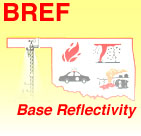DESCRIPTION: Base Reflectivity is one of the basic quantities that a Doppler radar (like NEXRAD) measures. The other base products NEXRAD produces are Base Velocity and Spectrum Width (which is not available via NIDS). Base Reflectivity basically corresponds to the amount of radiation that is scattered or reflected back to the radar by whatever targets are located in the radar beam at a given location. These targets can be hydrometeors (snow, rain drops, hail, cloud drops or ice particles) or other targets (dust, smoke, birds, airplanes, insects). The colors on the Base Reflectivity product correspond to the intensity of the radiation that was received by the radar antenna from a given location.
GENERAL INTERPRETATION: Several concepts apply to the interpretation of every radar product:
 Propagation of Radar Beam Propagation of Radar Beam
 Anomalous Propagation Anomalous Propagation
 General Relationship of Reflectivity (dBZ) to Rain Rate General Relationship of Reflectivity (dBZ) to Rain Rate
 Broadening of the Radar Beam Broadening of the Radar Beam
 Aspect Ratio Aspect Ratio
 Radar Horizon Radar Horizon
USING BASE REFLECTIVITY IN SEVERE WEATHER :
 Dry Line in Base Reflectivity Dry Line in Base Reflectivity
 Outflow Boundaries Outflow Boundaries
 Intersecting Boundaries: Cold Front & Dryline Intersecting Boundaries: Cold Front & Dryline
 Bounded Weak Echo Region (BWER) Bounded Weak Echo Region (BWER)
 Hail Core and 3-Body Scatter (Hail) Spike Hail Core and 3-Body Scatter (Hail) Spike
 Hook Echo and "V"-Notch Hook Echo and "V"-Notch
 Bow Echo Bow Echo
USING BASE REFLECTIVITY IN FLOODING :
 Training Echoes Training Echoes
USING BASE REFLECTIVITY IN WINTER WEATHER :
 Snow in Clear-Air Mode Snow in Clear-Air Mode
 Distinguising Precipitation Type Distinguising Precipitation Type
USING BASE REFLECTIVITY IN FIRE WEATHER :
 Recognizing Wind Shifts Recognizing Wind Shifts
|  Propagation of Radar Beam
Propagation of Radar Beam 